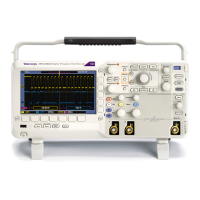How to ? Compensate passive probes
4. Select Probe Cal from the Vertical menu to open the Probe Setup control window.
5. Select the channel to which the probe is attached.
6. Click Compensate Probe to begin the procedure. The Probe Status indicator changes to Pass when the
procedure is complete. If the procedure does not pass, contact your local Tektronix service personnel.
7. Remove the connections from the terminals.
Compensate passive probes
Use this procedure to optimize gain and offset accuracy at the probe tip. Allow the instrument to warm
up before performing this procedure.
Perform the low frequency p robe compensation
(see page 573) for pa ssive probes.
NOTE. The probe compensation procedure is not recommended for the P5050 passive probes. These probes
have little gain or offset errors. However, you should perform this procedure for other passive probes.
Complete the following steps:
1. If you have not already done so, connect the probe to the instrument.
2. Conne
ct the probe to probe compensation (Fast Edge on some models) terminals as shown. Connect
only one probe at a time.
3. Sele
ct Probe Cal from the Vertical menu to open the Probe Compensation control window.
4. Select the channel to which the probe is attached.
5. Click Compensate Probe to begin the procedure. The Probe Status indicator changes to Pass when the
procedure is complete. If the procedure does not pass, contact your local Tektronix service personnel.
6. Remove the connections from the terminals.
572 DSA/DPO70000D, MSO/DPO/DSA70000C, DPO7000C, and MSO/DPO5000 Series

